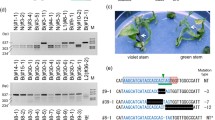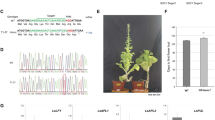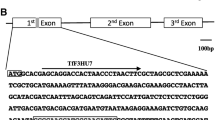Abstract
Key message
We obtained a complete mutant line of Petunia having mutations in both F3H genes via Cas9-ribonucleoproteins delivery, which exhibited a pale purplish pink flower color.
The CRISPR-Cas system is now revolutionizing agriculture by allowing researchers to generate various desired mutations in plants at will. In particular, DNA-free genome editing via Cas9-ribonucleoproteins (RNPs) delivery has many advantages in plants; it does not require codon optimization or specific promoters for expression in plant cells; furthermore, it can bypass GMO regulations in some countries. Here, we have performed site-specific mutagenesis in Petunia to engineer flower color modifications. We determined that the commercial Petunia cultivar ‘Madness Midnight’ has two F3H coding genes and designed one guide RNA that targets both F3H genes at once. Among 67 T0 plants regenerated from Cas9-RNP transfected protoplasts, we obtained seven mutant lines that contain mutations in either F3HA or F3HB gene and one complete mutant line having mutations in both F3H genes without any selectable markers. It is noteworthy that only the f3ha f3hb exhibited a clearly modified, pale purplish pink flower color (RHS 69D), whereas the others, including the single copy gene knock-out plants, displayed purple violet (RHS 93A) flowers similar to the wild-type Petunia. To the best of our knowledge, we demonstrated a precedent of ornamental crop engineering by DNA-free CRISPR method for the first time, which will greatly accelerate a transition from a laboratory to a farmer’s field.



Similar content being viewed by others
References
Andersson M, Turesson H, Olsson N, Fält A-S, Ohlsson P, Gonzalez MN, Samuelsson M, Hofvander P (2018) Genome editing in potato via CRISPR-Cas9 ribonucleoprotein delivery. Physiol Plant 164:378–384
Bae S, Park J, Kim J-S (2014) Cas-OFFinder: a fast and versatile algorithm that searches for potential off-target sites of Cas9 RNA-guided endonucleases. Bioinformatics 30:1473–1475
Baek K, Kim DH, Jeong J, Sim SJ, Melis A, Kim J-S, Jin E, Bae S (2016) DNA-free two-gene knockout in Chlamydomonas reinhardtii via CRISPR-Cas9 ribonucleoproteins. Sci Rep 6:30620
Bombarely A, Moser M, Amrad A, Bao M, Bapaume L, Barry CS, Bliek M, Boersma MR, Borghi L, Bruggmann R, Bucher M, D'Agostino N, Davies K, Druege U, Dudareva N, Egea-Cortines M, Delledonne M, Fernandez-Pozo N, Franken P, Grandont L, Heslop-Harrison JS, Hintzsche J, Johns M, Koes R, Lv X, Lyons E, Malla D, Martinoia E, Mattson NS, Morel P, Mueller LA, Muhlemann J, Nouri E, Passeri V, Pezzotti M, Qi Q, Reinhardt D, Rich M, Richert-Pöggeler KR, Robbins TP, Schatz MC, Schranz ME, Schuurink RC, Schwarzacher T, Spelt K, Tang H, Urbanus SL, Vandenbussche M, Vijverberg K, Villarino GH, Warner RM, Weiss J, Yue Z, Zethof J, Quattrocchio F, Sims TL, Kuhlemeier C (2016) Insight into the evolution of the Solanaceae from the parental genomes of Petunia hybrida. Nature Plants 2:16074
Brooks C, Nekrasov V, Lippman ZB, Van Eck J (2014) Efficient gene editing in tomato in the first generation using the clustered regularly interspaced short palindromic repeats/CRISPR-Associated9 system. Plant Physiol 166:1292–1297
Clark KA, Krysan PJ (2010) Chromosomal translocations are a common phenomenon in Arabidopsis thaliana T-DNA insertion lines. Plant J 64:990–1001
Feng Z, Mao Y, Xu N, Zhang B, Wei P, Yang D-L, Wang Z, Zhang Z, Zheng R, Yang L, Zeng L, Liu X, Zhu J-K (2014) Multigeneration analysis reveals the inheritance, specificity, and patterns of CRISPR/Cas-induced gene modifications in Arabidopsis. Proc Natl Acad Sci 111:4632–4637
Jupe F, Rivkin AC, Michael TP, Zander M, Motley ST, Sandoval JP, Slotkin RK, Chen H, Castanon R, Nery JR, Ecker JR (2019) The complex architecture and epigenomic impact of plant T-DNA insertions. PLoS Genet 15:e1007819
Kim S, Kim D, Cho SW, Kim J, Kim J-S (2014) Highly efficient RNA-guided genome editing in human cells via delivery of purified Cas9 ribonucleoproteins. Genome Res 24:1012–1019
Lin C-S, Hsu C-T, Yang L-H, Lee L-Y, Fu J-Y, Cheng Q-W, Wu F-H, Hsiao HC-W, Zhang Y, Zhang R, Chang W-J, Yu C-T, Wang W, Liao L-J, Gelvin SB, Shih M-C (2018) Application of protoplast technology to CRISPR/Cas9 mutagenesis: from single-cell mutation detection to mutant plant regeneration. Plant Biotechnol J 16:1295–1310
Ma X, Zhu Q, Chen Y, Liu Y-G (2016) CRISPR/Cas9 platforms for genome editing in plants: developments and applications. Mol Plant 9:961–974
Malnoy M, Viola R, Jung M-H, Koo O-J, Kim S, Kim J-S, Velasco R, Nagamangala Kanchiswamy C (2016) DNA-free genetically edited grapevine and apple protoplast using CRISPR/Cas9 ribonucleoproteins. Front Plant Sci 7:1904
Nacry P, Camilleri C, Courtial B, Caboche M, Bouchez D (1998) Major chromosomal rearrangements induced by T-DNA transformation in Arabidopsis. Genetics 149:641–650
Nishihara M, Higuchi A, Watanabe A, Tasaki K (2018) Application of the CRISPR/Cas9 system for modification of flower color in Torenia fournieri. BMC Plant Biol 18:331
Pan C, Ye L, Qin L, Liu X, He Y, Wang J, Chen L, Lu G (2016) CRISPR/Cas9-mediated efficient and heritable targeted mutagenesis in tomato plants in the first and later generations. Sci Rep 6:24765
Park J, Bae S, Kim J-S (2015) Cas-Designer: a web-based tool for choice of CRISPR-Cas9 target sites. Bioinformatics 31:4014–4016
Park J, Bae S, Lim K, Kim J-S (2016) Cas-analyzer: an online tool for assessing genome editing results using NGS data. Bioinformatics 33:286–288
Stehmann JR, Lorenz-Lemke AP, Freitas LB, Semir J (2009) The genus Petunia. In: Gerats T, Strommer J (eds) Petunia: evolutionary, developmental and physiological genetics. Springer, New York, pp 1–28
Subburaj S, Tu L, Jin Y-T, Bae S, Seo PJ, Jung YJ, Lee G-J (2016a) Targeted genome editing, an alternative tool for trait improvement in horticultural crops. Hortic Environ Biotechnol 57:531–543
Subburaj S, Chung SJ, Lee C, Ryu SM, Kim DH, Kim JS, Bae S, Lee GJ (2016b) Site-directed mutagenesis in Petunia x hybrida protoplast system using direct delivery of purified recombinant Cas9 ribonucleoproteins. Plant Cell Rep 35:1535–1544
Suzuki K-i, Xue H-m, Tanaka Y, Fukui Y, Fukuchi-Mizutani M, Murakami Y, Katsumoto Y, Tsuda S, Kusumi T (2000) Flower color modifications of Torenia hybrida by cosuppression of anthocyanin biosynthesis genes. Mol Breeding 6:239–246
Tan J, Wang M, Tu L, Nie Y, Lin Y, Zhang X, Zhang J (2013) The flavonoid pathway regulates the petal colors of cotton flower. PLoS ONE 8(8):e72364
Tsuda S, Fukui Y, Nakamura N, Katsumoto Y, Yonekura-Sakakibara K, Fukuchi-Mizutani M, Ohira K, Ueyama Y, Ohkawa H, Holton TA, Kusumi T, Tanaka Y (2004) Flower color modification of Petunia hybrida commercial varieties by metabolic engineering. Plant Biotechnol 21:377–386
Ueyama Y, Katsumoto Y, Fukui Y, Fukuchi-Mizutani M, Ohkawa H, Kusumi T, Iwashita T, Tanaka Y (2006) Molecular characterization of the flavonoid biosynthetic pathway and flower color modification of Nierembergia sp. Plant Biotechnol 23:19–24
Vandenbussche M, Chambrier P, Rodrigues Bento S, Morel P (2016) Petunia, your next supermodel? Front Plant Sci 7:72
Waltz E (2016) Gene-edited CRISPR mushroom escapes US regulation. Nature 532:293
Woo JW, Kim J, Kwon SI, Corvalán C, Cho SW, Kim H, Kim S-G, Kim S-T, Choe S, Kim J-S (2015) DNA-free genome editing in plants with preassembled CRISPR-Cas9 ribonucleoproteins. Nat Biotechnol 33:1162
Xu J, Kang B-C, Naing AH, Bae S-J, Kim J-S, Kim H, Kim CK (2020) CRISPR/Cas9-mediated editing of 1-aminocyclopropane-1-carboxylate oxidase1 enhances Petunia flower longevity. Plant Biotechnol J 18:287–297
Zhang H, Zhang J, Wei P, Zhang B, Gou F, Feng Z, Mao Y, Yang L, Zhang H, Xu N, Zhu J-K (2014) The CRISPR/Cas9 system produces specific and homozygous targeted gene editing in rice in one generation. Plant Biotechnol J 12:797–807
Zhang B, Yang X, Yang C, Li M, Guo Y (2016) Exploiting the CRISPR/Cas9 system for targeted genome mutagenesis in Petunia. Sci Rep 6:20315
Zhang Q, Xing H-L, Wang Z-P, Zhang H-Y, Yang F, Wang X-C, Chen Q-J (2018) Potential high-frequency off-target mutagenesis induced by CRISPR/Cas9 in Arabidopsis and its prevention. Plant Mol Biol 96:445–456
Zuker A, Tzfira T, Ben-Meir H, Ovadis M, Shklarman E, Itzhaki H, Forkmann G, Martens S, Neta-Sharir I, Weiss D, Vainstein A (2002) Modification of flower color and fragrance by antisense suppression of the flavanone 3-hydroxylase gene. Mol Breed 9:33–41
Acknowledgments
This work was supported by grants from the Next Generation BioGreen 21 Program (No. PJ01319301 to S.B. and No. PJ01319303 to G.J.L). J.Y. was also supported by the Stadelmann-Lee Scholarship Fund, Seoul National University, Seoul, Korea.
Author information
Authors and Affiliations
Corresponding authors
Ethics declarations
Conflict of interest
G.J.L., T.L., and S.S. are co-inventors on a patent application related to the methods described in this manuscript.
Additional information
Communicated by Neal Stewart.
Publisher's Note
Springer Nature remains neutral with regard to jurisdictional claims in published maps and institutional affiliations.
Electronic supplementary material
Below is the link to the electronic supplementary material.
Rights and permissions
About this article
Cite this article
Yu, J., Tu, L., Subburaj, S. et al. Simultaneous targeting of duplicated genes in Petunia protoplasts for flower color modification via CRISPR-Cas9 ribonucleoproteins. Plant Cell Rep 40, 1037–1045 (2021). https://doi.org/10.1007/s00299-020-02593-1
Received:
Accepted:
Published:
Issue Date:
DOI: https://doi.org/10.1007/s00299-020-02593-1




